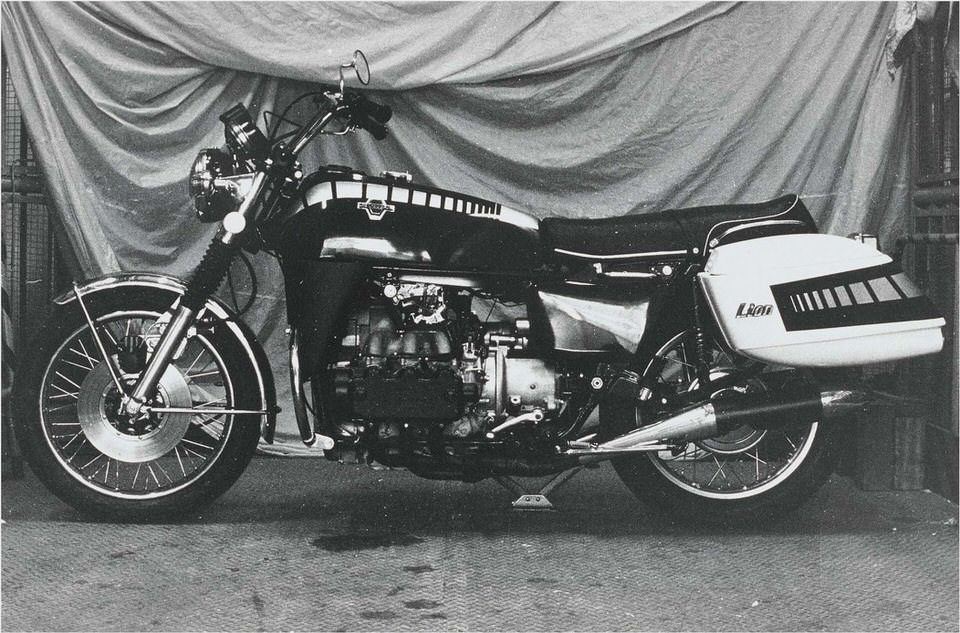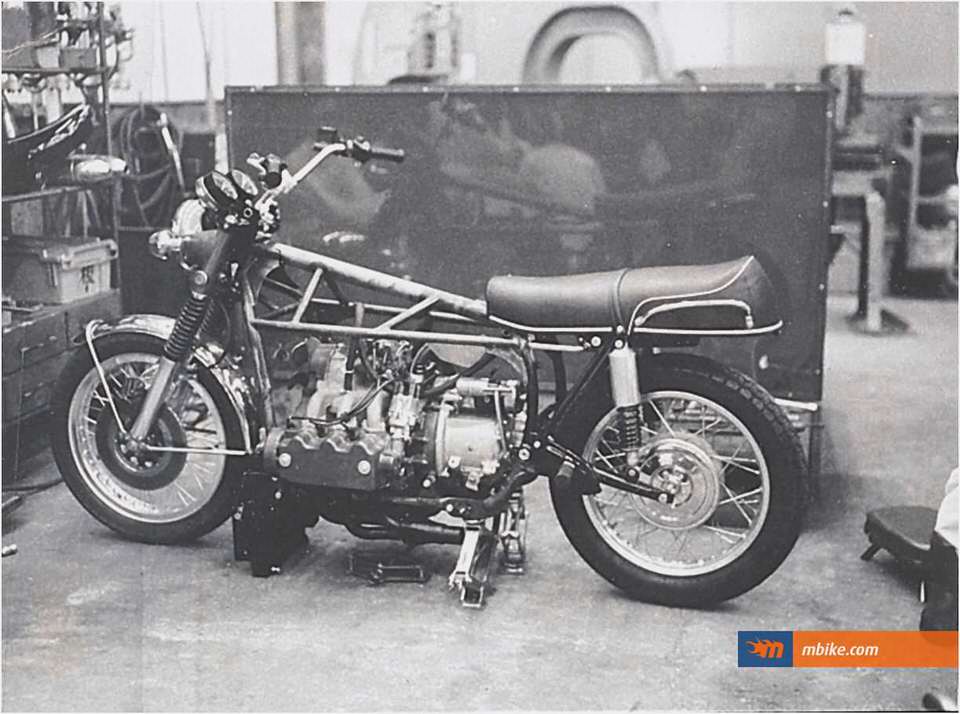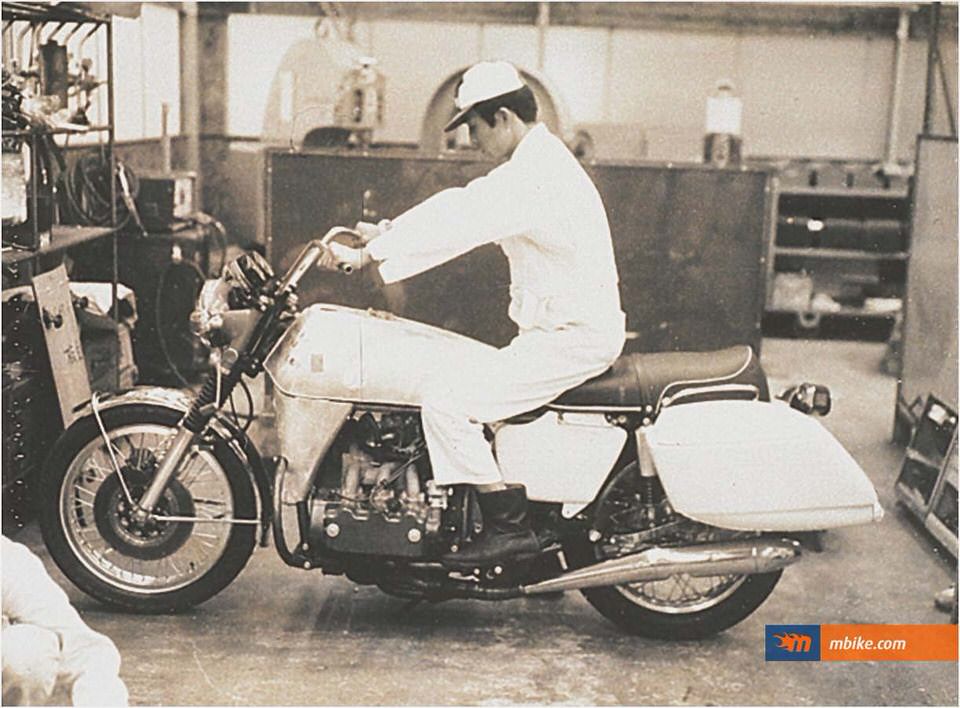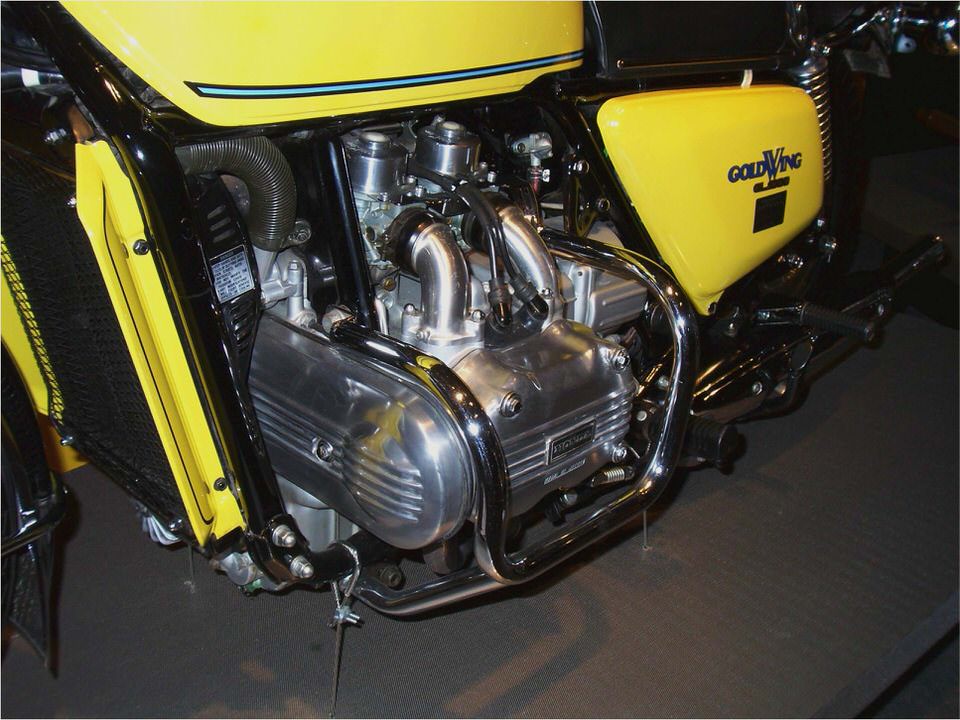
Honda GL1000 Goldwing Road Test
When Honda introduced the first of the GL series at the 1974, Cologne show the rest of the world could never have imagined it would create a whole new breed of motorcyclist and riding style, let alone still be around in one form or another today. Most had considered a larger version of the CB750 to be on the cards, however few had guessed correctly. Now in its fourth decade and its fifth generation of continued production the Goldwing is a true phenomenon of modern motorcycling.
The machine combined what appeared to be a perfectly normal, conventional chassis and cycle parts wrapped around nothing less than a car engine to create a perfectly well behaved machine. The overhead camshaft flat-four resembled something out of the back of a Volkswagen car and is technically nothing out of the ordinary, just good sound engineering practise put together in typical Honda style. Despite looking like an automobile engine inside the flat four was all pure motorcycle with large valves and hemispherical combustion chambers producing a healthy output for the period, pumping four large pistons that sat on top of a CB750 like five speed gearbox.
Although often ridiculed for being too big and heavy in reality the GL1000 is a surprisingly nimble machine, hiding its not inconsiderable mass well thanks to the low slung fuel tank and flat layout of the horizontally opposed engine, in effect there is little of any weight above ankle height, even the gearbox is situated deep in the bilges, making the machine easy to throw around even at speed. Whilst on the subject of speed for its time the GL was no slouch either being as fast as the benchmark sports motorcycles with a top speed a shade over the 125mph mark and a 12.73 second standing quarter, faster than a Porsche 911.
In use the early GL1000 is a real doddle to get the hang of with few vices, save for the spongy rear shocks that once loaded up are little problem. With a wheelbase a shade longer than a “normal” motorcycle the general handling is impressive, combine this with good brakes and a laid-back demeanour and riding the wing is addictive fun.
It does feel at times however like the brakes could snap the front forks such is the combined power of them and the weight backing up behind the front wheel, it is all in the mind however and I cant recall an instance of any Goldwings snapping in half at the squeeze of the front bake lever, none the less Honda did fit larger and larger diameter forks as the model developed over the years. A strange idea is the size of the rear brake being 12mm larger in diameter than the front rotors and also grabbed by a more powerful twin opposed caliper rather than the single piston floating type used on the front. The rear disc effectively has a twenty percent bigger swept area for the pads to grip than the front discs making it way too powerful especially when stomped on by your best size nines.
Ground clearance is the limiting factor in cornering but one soon learns to ride accordingly by going in that little bit steadier before using the torque to stomp out, exiting probably as fast as if you had tried to go around on your knee but without decking the can covers. Of course many degrees of lean angle are eaten up by those hungry shocks and fitting a longer stronger pair will aid the situation no end.
The flat-four engine is a silkily smooth delight, even now some thirty years on, so one can only imagine the impact upon the biking community way back at the types launch, pulling from way down low in the rev range and maintaining a smooth power curve all the way to its redline with peak power being made a seven thousand rpm. The power is continuous and certainly up there with the Superbikes of the day with acceleration times and indeed top speeds equal to the mighty Z1 et al.
Five perfectly chosen ratios seamlessly slot into the rev range to give the big machine yet another nudge with every shift towards its impressive three figure top speed. If you look in the biking bible under the entry for smooth gearboxes, nine times out of ten it will say “see Honda” and that is certainly the case here, aided by a clutch so light it would be better served on a middleweight machine, not a big heavy weight bike like this.
You can move weight around within a structure to help, or indeed totally destroy its balance, but you cannot ever lose that weight, it will always be there. It is this bulk that totally destroys the rear suspensions best plans of keeping the plot in shape, being a very basic design of unit the damping fails miserably when passing all but the very smoothest if tarmac.
In typical Japanese testing style no doubt this bike did thousands of miles around a race track being tested by professional riders, this practice common in the sixties and seventies almost without exception failed to highlight a machines worst handling habits and really only served to push horse power limits to the maximum. Consequently we saw a generation of Jap machines that looked and went superbly yet handled relatively poorly particularly when compared to the Latin machines that were usually developed in a more laid back and hands on style.
The GL’s general demeanour is fine in a straight line, providing cats eyes and thick white lines are steered away from but get in a bit of a mess mid corner and the big Wing gets all squirrely with the rear trying to do a better job of steering than the front, for a while it manages this challenge and the worse thing you can do is back off the throttle. The best thing you can do however is junk the original shocks and fit a pair of more heavily damped units.
Shocks apart, the only real tangible fault that you can find with the GL1000, bearing in mind its age and status in the biking world, is the rather pessimistic electric fuel gauge, the fitting of which was yet another first in the biking scheme of things. To be fair it was good of Honda to fit one where it is, smack bang in the middle of the faux tank where it would grab your attention at the right moment and had it been blessed with stunning or even half accuracy it would have been a good thing however the reading does drop, both suddenly and erratically, leading you into thinking you had better find a gas station pretty soon, the reality of the situation is however that you will have many more miles left in the tank.
Honda GL1000 Goldwing Model History
The Goldwing project began in 1970, soon after the completion and subsequent launch of the radical CB750 four, the design brief was simple it must have a bigger capacity than both the Z1 Kawasaki and BMW R90 and produce more power and carry a greater load than the 1200 Electroglide. The aim was clear, challenge and overcome the domination of Harley Davidson in the US cruiser market.
The Honda research people were keen to explore the possibilities of ever increasing capacities taking the 750cc concept, first seen with the 1968 CB, onto greater things with more power and torque being produced to good effect. The prototype GL nicknamed the M1 or king of motorcycles was an elaborate design featuring a 1400cc six cylinder engine not unlike the later 1500cc Goldwing and Valkyrie of the mid 1980’s.
Once the basics of the design were forged the rest took care of itself mainly out of necessity, of course a flat engine whether it be four or six cylinder either has to be liquid cooled or feature huge ducting to direct air to the rear cylinders as they sit behind their hot mates up front. The huge torque forces created by the crank spinning in line with the frame was cleverly offset, unlike the similarly powered Guzzi and BMW’s, by driving the weighted alternator in the opposite direction (the crank spins clockwise when viewed from the front) effectively dissipating the energy to reduce to nothing the negative impact upon the bike.
The engine was quiet too with rubber belts driving the camshafts and the water jackets hiding any extraneous sounds from the top end. The perfect primary balance kept everything smooth while a five-speed gearbox, driving a wet multi plate clutch, handled the transmission via a large shaft to the rear wheel. Ignition wise once again there was nothing spectacular providing the sparks, no CDI or the like just a pair of good old fashion points although the advance retard mechanism was actuated via a vacuum system to take into account engine load.
Build quality was superb featuring wheels laced with wire spokes attached to aluminium rims, later models soon had the cheaper to make Comstar design, while the fake fuel tank up top opened up to reveal the electrics and also some storage space. The real fuel tank is situated below the seat very near the centre of gravity and helps melt away those 584 pounds of excess baggage far better than if the five gallons had been balanced on top of the frame like a normal bike.
The type, despite a slow start with a mere four thousand sold in its debut year against a prediction far higher than that, did eventually take off in the states and this in turn led to the opening and subsequent production of GL1000’s in America although considered a risky move the first American built Wings left the factory in September 1979. That year the model also was increased in capacity via a 3mm larger bore size to 1083cc and with this change cam a new CDI ignition system greatly helping the types reliability.
Smaller carburettors were continually fitted year on year to aid fuel consumption, this was a regular area for criticism in the press at the time with some journos reporting figures as low as 15 mpg during sustained high speed use, the tank was also small for a long distance cruiser greatly exacerbating the problem of a heavy right wrist. The gearbox was revised too, making the towing of trailers and low speed pottering easier, along with a lowered seat and a lengthened wheelbase all aimed at making the king of tourers even more capable of the job in hand.
Honda wandered off a few years after the types introduction to fully develop the sportier models like the CBX and the CB1100R but they did return and the GL grew in both capacity and stature within the two-wheeled community. The Goldwing is a massively popular lifestyle motorcycle possessing one of the largest followings, if not the largest, of any machine ever made and is without doubt the most developed with an unbroken production run that has seen the basic GL1000 grow from an unfaired Superbike to the gargantuan long range six cylinder super cruiser we know today.
Honda GL1000 1975 Specifications
Engine – liquid cooled horizontally opposed four OHC
Capacity – 999cc
Bore stroke – 72 mm x 61.4mm

Carburetion – 32mm CV
Max Power – 80 bhp @7000rpm
Torque – 63 ft-lb @5500 rpm
Ignition – contact breaker mechanical advance
Transmission – Five-speed wet multi plate clutch shaft drive
Frame – Steel twin loop cradle
Suspension – 37mm telescopic forks twin rear shocks spring rate adjustable
Wheels – 3.50 x 19 front, 4.50 x 17 rear
Brakes – 280mm Dual disc, single piston floating caliper. 292mm Single disc, twin opposed piston caliper
Wheelbase – 1545mm
Weight – 265 kgs
Fuel capacity – 22litres
Top speed – 125mph
Honda GL1000 Goldwing Gallery


- RideApart Review: 2013 Honda CBR500R ABS RideApart
- Honda dishes the skinny on 2012 motorcycle line – Autoblog
- H7 Philips X-treme Vision +100% Headlight Bulbs (pair)
- Armour Bodies Pro Series Race Bodywork, ’05-’06 Honda CBR600RR…
- Honda CBR150R Long Term Review MotorBeam – Indian Car Bike News…

